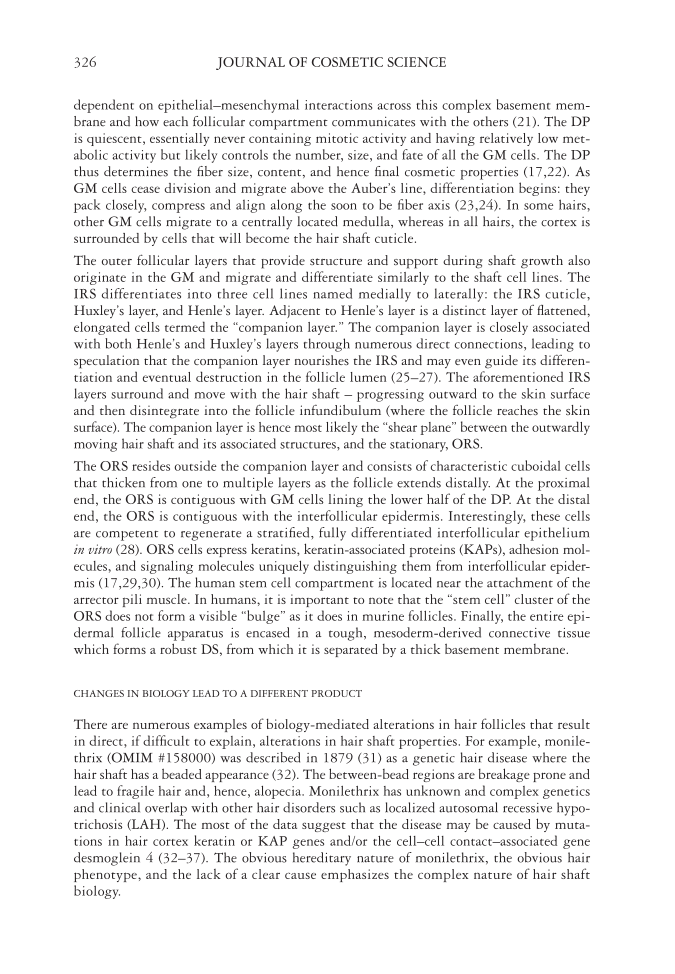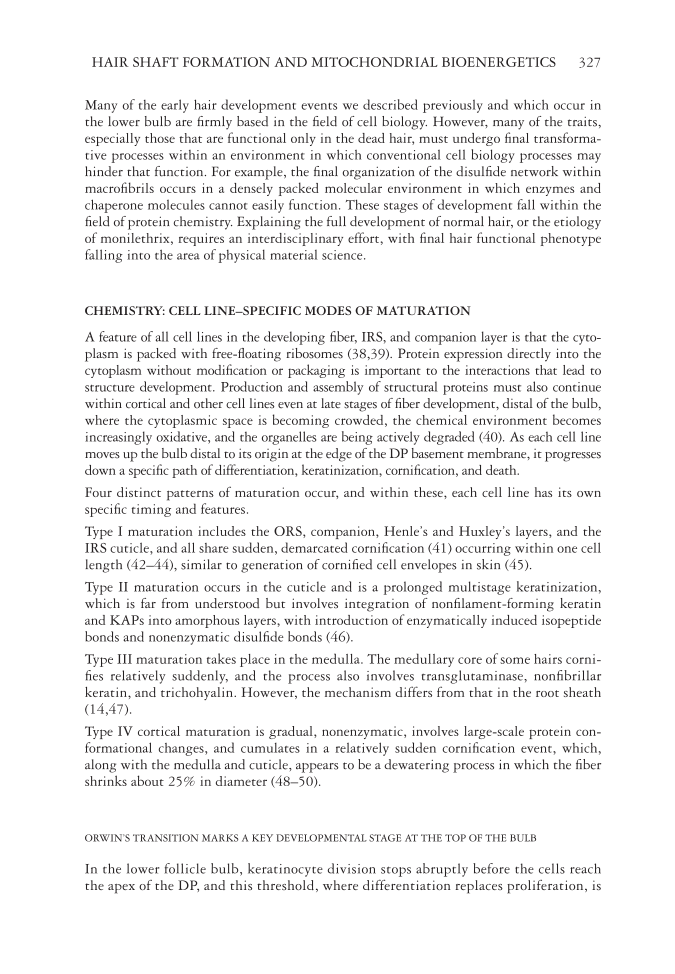JOURNAL OF COSMETIC SCIENCE 326 dependent on epithelial–mesenchymal interactions across this complex basement mem- brane and how each follicular compartment communicates with the others (21). The DP is quiescent, essentially never containing mitotic activity and having relatively low met- abolic activity but likely controls the number, size, and fate of all the GM cells. The DP thus determines the fi ber size, content, and hence fi nal cosmetic properties (17,22). As GM cells cease division and migrate above the Auber’s line, differentiation begins: they pack closely, compress and align along the soon to be fi ber axis (23,24). In some hairs, other GM cells migrate to a centrally located medulla, whereas in all hairs, the cortex is surrounded by cells that will become the hair shaft cuticle. The outer follicular layers that provide structure and support during shaft growth also originate in the GM and migrate and differentiate similarly to the shaft cell lines. The IRS differentiates into three cell lines named medially to laterally: the IRS cuticle, Huxley’s layer, and Henle’s layer. Adjacent to Henle’s layer is a distinct layer of fl attened, elongated cells termed the “companion layer.” The companion layer is closely associated with both Henle’s and Huxley’s layers through numerous direct connections, leading to speculation that the companion layer nourishes the IRS and may even guide its differen- tiation and eventual destruction in the follicle lumen (25–27). The aforementioned IRS layers surround and move with the hair shaft – progressing outward to the skin surface and then disintegrate into the follicle infundibulum (where the follicle reaches the skin surface). The companion layer is hence most likely the “shear plane” between the outwardly moving hair shaft and its associated structures, and the stationary, ORS. The ORS resides outside the companion layer and consists of characteristic cuboidal cells that thicken from one to multiple layers as the follicle extends distally. At the proximal end, the ORS is contiguous with GM cells lining the lower half of the DP. At the distal end, the ORS is contiguous with the interfollicular epidermis. Interestingly, these cells are competent to regenerate a stratifi ed, fully differentiated interfollicular epithelium in vitro (28). ORS cells express keratins, keratin-associated proteins (KAPs), adhesion mol- ecules, and signaling molecules uniquely distinguishing them from interfollicular epider- mis (17,29,30). The human stem cell compartment is located near the attachment of the arrector pili muscle. In humans, it is important to note that the “stem cell” cluster of the ORS does not form a visible “bulge” as it does in murine follicles. Finally, the entire epi- dermal follicle apparatus is encased in a tough, mesoderm-derived connective tissue which forms a robust DS, from which it is separated by a thick basement membrane. CHANGES IN BIOLOGY LEAD TO A DIFFERENT PRODUCT There are numerous examples of biology-mediated alterations in hair follicles that result in direct, if diffi cult to explain, alterations in hair shaft properties. For example, monile- thrix (OMIM #158000) was described in 1879 (31) as a genetic hair disease where the hair shaft has a beaded appearance (32). The between-bead regions are breakage prone and lead to fragile hair and, hence, alopecia. Monilethrix has unknown and complex genetics and clinical overlap with other hair disorders such as localized autosomal recessive hypo- trichosis (LAH). The most of the data suggest that the disease may be caused by muta- tions in hair cortex keratin or KAP genes and/or the cell–cell contact–associated gene desmoglein 4 (32–37). The obvious hereditary nature of monilethrix, the obvious hair phenotype, and the lack of a clear cause emphasizes the complex nature of hair shaft biology.
HAIR SHAFT FORMATION AND MITOCHONDRIAL BIOENERGETICS 327 Many of the early hair development events we described previously and which occur in the lower bulb are fi rmly based in the fi eld of cell biology. However, many of the traits, especially those that are functional only in the dead hair, must undergo fi nal transforma- tive processes within an environment in which conventional cell biology processes may hinder that function. For example, the fi nal organization of the disulfi de network within macrofi brils occurs in a densely packed molecular environment in which enzymes and chaperone molecules cannot easily function. These stages of development fall within the fi eld of protein chemistry. Explaining the full development of normal hair, or the etiology of monilethrix, requires an interdisciplinary effort, with fi nal hair functional phenotype falling into the area of physical material science. CHEMISTRY: CELL LINE–SPECIFIC MODES OF MATURATION A feature of all cell lines in the developing fi ber, IRS, and companion layer is that the cyto- plasm is packed with free-fl oating ribosomes (38,39). Protein expression directly into the cytoplasm without modifi cation or packaging is important to the interactions that lead to structure development. Production and assembly of structural proteins must also continue within cortical and other cell lines even at late stages of fi ber development, distal of the bulb, where the cytoplasmic space is becoming crowded, the chemical environment becomes increasingly oxidative, and the organelles are being actively degraded (40). As each cell line moves up the bulb distal to its origin at the edge of the DP basement membrane, it progresses down a specifi c path of differentiation, keratinization, cornifi cation, and death. Four distinct patterns of maturation occur, and within these, each cell line has its own specifi c timing and features. Type I maturation includes the ORS, companion, Henle’s and Huxley’s layers, and the IRS cuticle, and all share sudden, demarcated cornifi cation (41) occurring within one cell length (42–44), similar to generation of cornifi ed cell envelopes in skin (45). Type II maturation occurs in the cuticle and is a prolonged multistage keratinization, which is far from understood but involves integration of nonfi lament-forming keratin and KAPs into amorphous layers, with introduction of enzymatically induced isopeptide bonds and nonenzymatic disulfi de bonds (46). Type III maturation takes place in the medulla. The medullary core of some hairs corni- fi es relatively suddenly, and the process also involves transglutaminase, nonfi brillar keratin, and trichohyalin. However, the mechanism differs from that in the root sheath (14,47). Type IV cortical maturation is gradual, nonenzymatic, involves large-scale protein con- formational changes, and cumulates in a relatively sudden cornifi cation event, which, along with the medulla and cuticle, appears to be a dewatering process in which the fi ber shrinks about 25% in diameter (48–50). ORWIN’S TRANSITION MARKS A KEY DEVELOPMENTAL STAGE AT THE TOP OF THE BULB In the lower follicle bulb, keratinocyte division stops abruptly before the cells reach the apex of the DP, and this threshold, where differentiation replaces proliferation, is
Purchased for the exclusive use of nofirst nolast (unknown) From: SCC Media Library & Resource Center (library.scconline.org)









































































































